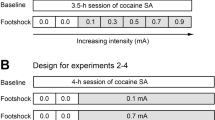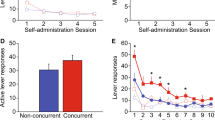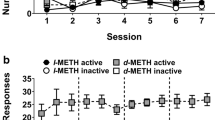Abstract
Rationale
Experimental animal studies have shown that repeated administration of psychostimulants, such as methamphetamine (METH), results in an altered behavioral response profile, which includes the sensitization of both locomotor and stereotyped behaviors. Although sensitization of these behaviors has been characterized in detail during bolus, investigator-administered drug administration, little is known about the development or expression of stereotypies during psychostimulant self-administration.
Objective/methods
The present study investigated in rats the expression of focused stereotyped behaviors during an extended access, escalation procedure of METH self-administration. Over several weeks during stepwise-extended daily access to METH (3, 6, and 12 h) followed by exposure to 24-h “binges,” rats gradually increased daily drug intake.
Results
During the escalation procedure, the rats' behavioral response evolved from locomotor activation to progressively more focused stereotypies, culminating in continuous oral behaviors (licking, gnawing, and chewing), interrupted only by episodic lever presses. Sensitization of stereotyped behaviors was evident, particularly with regard to oral behaviors that exhibited a more rapid onset and intensification in the apparent absence of greater drug intake.
Conclusions
Our data demonstrate that stepwise-extended daily access to METH (3, 6, 12, and 24 h) self-administration in rats closely approximates motivational, pharmacokinetic, as well as behavioral patterns of human METH abuse. The accompanied appearance of sensitization of intense focused stereotyped behaviors, which is probably a consequence of escalation of drug intake, resembles stereotypies associated with investigator-initiated METH administration and may parallel the development of stimulant-induced psychosis seen in human abusers.





Similar content being viewed by others
References
Angrist B (1994) Amphetamine psychosis: clinical variations of the syndrome. In: Cho AK, Segal DS (eds) Amphetamine and its analogues. Academic, San Diego, pp 387–414
Angrist BM, Gershon S (1970) The phenomenology of experimentally induced amphetamine psychosis-preliminary observations. Biol Psychiatry 2:95–107
Angrist B, Corwin J, Bartlik B, Cooper T (1987) Early pharmacokinetics and clinical effects of oral d-amphetamine in normal subjects. Biol Psychiatry 22:1357–1368
Belcher AM, Feinstein EM, O'Dell SJ, Marshall JF (2008) Methamphetamine influences on recognition memory: comparison of escalating and single-day dosing regimens. Neuropsychopharmacology 33:1453–1463
Bell DS (1973) The experimental reproduction of amphetamine psychosis. Arch Gen Psychiatry 29:35–40
Brady KT, Lydiard RB, Malcom R, Ballenger JC (1991) Cocaine-induced psychosis. J Clin Psychiatry 52:509–512
Cadet JL, Jayanthi S, Deng XL (2003) Speed kills: cellular and molecular bases of methamphetamine-induced nerve terminal degeneration and neuronal apoptosis. FASEB Journal 17:1775–1788
Canales JJ, Graybiel AM (2000) A measure of striatal function predicts motor stereotypy. Nat Neurosci 3:377–383
Chang L, Alicata D, Ernst T, Volkow N (2007) Structural and metabolic brain changes in the striatum associated with methamphetamine abuse. Addiction 102(Suppl 1):16–32
Cho AK, Melega WP, Kuczenski R, Segal DS (2001) Relevance of pharmacokinetic parameters in animal models of methamphetamine abuse. Synapse 39:161–166
Dalley JW, Cardinal RN, Robbins TW (2004) Prefrontal executive and cognitive functions in rodents: neural and neurochemical substrates. Neurosci Biobehav Rev 28:771–784
Dalley JW, Lääne K, Theobald DE et al (2007) Enduring deficits in sustained visual attention during withdrawal of intravenous methylenedioxymethamphetamine self-administration in rats: results from a comparative study with d-amphetamine and methamphetamine. Neuropsychopharmacology 32:1195–1206
Davidson C, Gow AJ, Lee TH, Ellinwood EH (2001) Methamphetamine neurotoxicity: necrotic and apoptotic mechanisms and relevance to human abuse and treatment. Brain Res Rev 36:1–22
Davis JM, Schlemmer RF Jr (1980) The amphetamine psychosis. In: Caldwell J (ed) Amphetamines and related stimulants: chemical, biological, clinical and social aspects. CRC, Boca Raton, pp 161–173
Druhan JP, Geyer MA, Valentino RJ (1998) Lack of sensitization to the effects of d-amphetamine and apomorphine on sensorimotor gating in rats. Psychopharmacology 135:296–304
Ellinwood EH Jr, Sudilovsky A, Nelson LM (1973) Evolving behavior in the clinical and experimental amphetamine (model) psychosis. Am J Psychiatry 130:1088–1093
Eshleman AJ, Wolfrum K, Mash DC, Christensen K, Janowsky A (2001) Drug interactions with the dopamine transporter in cryopreserved human caudate. J Pharmacol Exp Ther 296:442–449
Fischman MW, Schuster CR (1974) Tolerance development to chronic methamphetamine intoxication in the rhesus monkey. Pharmacol Biochem Behav 2:503–508
Fischman MW, Schuster CR (1977) Long-term behavioral changes in the rhesus monkey after multiple daily injections of d-methylamphetamine. J Pharmacol Exp Ther 201:593–605
Fowler SC, Covington HE 3rd, Miczek KA (2007) Stereotyped and complex motor routines expressed during cocaine self-administration: results from a 24-h binge of unlimited cocaine access in rats. Psychopharmacol 192:465–478
Gawin FH, Khalsa ME (1996) Sensitization and “street” stimulant addiction. In: Majewska MD (ed) Neurotoxicity and neuropathology associated with stimulant abuse. NIDA Research Monograph Series. US Government Printing Office, Washington, pp 224–250
Hadamitzky M, Markou A, Kuczenski R (2011) Extended access to methamphetamine self-administration affects sensorimotor gating in rats. Behav Brain Res 217:386–390
Hemby SE, Co C, Koves TR, Smith JE, Dworkin SI (1997) Differences in extracellular dopamine concentrations in the nucleus accumbens during response-dependent and response-independent cocaine administration in the rat. Psychopharmacology 133:7–16
Jacobs EH, Smit AB, De Vries TJ, Schoffelmeer AN (2003) Neuroadaptive effects of active versus passive drug administration in addiction research. Trends Pharmacol Sci 24:566–573
Kalivas PW (2002) Neurocircuitry of Addiction. In: Davis KL, Charney D, Coyle JT, Nemeroff C (eds) Neuropsychopharmacology: The Fifth Generation of Progress. American Collge of Neuropsychopharmacology, pp 1357–1366
Kalivas PW, Sorg BA, Hooks MS (1993) The pharmacology and neural circuitry of sensitization to psychostimulants. Behav Pharmacol 4:315–334
Kita T, Wagner GC, Nakashima T (2003) Current research on methamphetamine-induced neurotoxicity: Animal models of monoamine disruption. Japan J Pharmacol 92:178–195
Kitamura O, Wee S, Specio SE, Koob GF, Pulvirenti L (2006) Escalation of methamphetamine self-administration in rats: a dose-effect function. Psychopharmacology 186:48–53
Kiyatkin EA, Brown PL (2004) Brain temperature fluctuations during passive vs. active cocaine administration: clues for understanding the pharmacological determination of drug-taking behavior. Brain Res 1005:101–116
Kramer JC, Fischman VS, Littlefield DC (1967) Amphetamine abuse. Pattern and effects of high dose taken intravenously. JAMA 201:305–309
Kuczenski R, Segal D (1989) Concomitant characterization of behavioral and striatal neurotransmitter response to amphetamine using in vivo microdialysis. J Neurosci 9:2051–2065
Kuczenski R, Segal DS, Weinberger SB, Browne RG (1982) Evidence that a behavioral augmentation following repeated amphetamine administration does not involve peripheral mechanisms. Pharmacol Biochem Behav 17:547–553
Kuczenski R, Everall IP, Crews L, Adame A, Grant I, Masliah E (2007) Escalating dose-multiple binge methamphetamine exposure results in degeneration of the neocortex and limbic system in the rat. Exp Neurol 207:42–51
Kuczenski R, Segal DS, Melega WP, Lacan L, McCunney SJ (2009) Human methamphetamine pharmacokinetics simulated in the rat: behavioral and neurochemical effects of a 72-h binge. Neuropsychopharmacology 34:2430–2441
Martinez D, Slifstein M, Broft A, Mawlawi T, Hwang DR, Huang YY, Cooper T, Kegeles L, Zarahn E, Abi-Dargham A, Haber SN, Laruelle T (2003) Imaging human mesolimbic dopamine transmission with positron emission tomography. Part II: Amphetamine-induced dopamine release in the functional subdivisions of the striatum. J Cerebr Blood F Met 23:285-300
McCann UD, Ricaurte GA (2004) Amphetamine neurotoxicity: accomplishments and remaining challenges. Neurosci Biobehav Rev 27:821–826
Melega WP, Cho AK, Harvey D, Laćan G (2007) Methamphetamine blood concentrations in human abusers: application to pharmacokinetic modeling. Synapse 61:216–220
Meredith CW, Jaffe C, Ang-Lee K, Saxon AJ (2005) Implications of chronic meth-amphetamine use: a literature review. Harv Rev Psychiatry 13:141–154
Nordahl TE, Salo R, Leamon M (2003) Neuropsychological effects of chronic methamphetamine use on neurotransmitters and cognition: a review. J Neuropsychiatry Clin Neurosci 15:317–325
O'Neil ML, Kuczenski R, Segal DS, Cho AK, Lacan G, Melega WP (2006) Escalating dose pretreatment induces pharmacodynamic and not pharmacokinetic tolerance to a subsequent high-dose methamphetamine binge. Synapse 60:465–473
Owens MJ, Morgan WN, Plott SJ, Nemeroff CB (1997) Neurotransmitter receptor and transporter binding profile of antidepressants and their metabolites. J Pharmacol Exp Ther 283:1305–1322
Post RM, Kopanda RT (1976) Cocaine, kindling, and psychosis. Am J Psychiatry 133:627–634
Randrup A, Munkvad I (1967) Stereotyped activities produced by amphetamine in several animal species and man. Psychopharmacologia 11:300–310
Randrup A, Munkvad I (1972) Influence of amphetamines on animal behaviour: stereotypy, functional impairment and possible animal-human correlations. Psychiatr Neurol Neurochir 75:193–202
Ridley RM (1994) The psychology of perserverative and stereotyped behaviour. Prog Neurobiol 44:221–231
Robinson TE, Becker JB (1986) Enduring changes in brain and behavior produced by chronic amphetamine administration: a review and evaluation of animal models of amphetamine psychosis. Brain Res Rev 11:157–198
Rogers JL, De Santis S, See RE (2008) Extended methamphetamine self-administration enhances reinstatement of drug seeking and impairs novel object recognition in rats. Psychopharmacology 199:615–624
Rylander G (1969) Clinical and medico-criminological aspects of addiction to central stimulating drugs. In: Sjoqvist F, Tottie M (eds) Abuse of central stimulants. Almqvist W Forlag AB, Stockholm, pp 11–15
Rylander G (1972) Psychoses and the punding and choreiform syndromes in addiction to central stimulant drugs. Psychiatr Neurol Neurochir 75:203–212
Satel SL, Southwick SM, Gawin FH (1991) Clinical features of cocaine-induced paranoia. Am J Psychiatry 148:495–498
Schiorring E (1977) Changes in individual and social behavior induced by amphetamine and related compounds in monkeys and man. In: Ellinwood EH Jr, Kilbey MJ (eds) Cocaine and other stimulants. Raven, New York, pp 481–522
Schmidt CJ, Gehlert DR, Peat MA, Sonsalla PK, Hanson GR, Wamsley JK, Gibb JW (1985) Studies on the mechanism of tolerance to methamphetamine. Brain Res 343:305–313
Schuster CR, Fischman MW (1975) Amphetamine toxicity: behavioral and neuropathological indexes. Fed Proc 34:1845–1851
Schwendt M, Rocha A, See RE, Pacchioni AM, McGinty JF, Kalivas PW (2009) Extended methamphetamine self-administration in rats results in a selective reduction of dopamine transporter levels in the prefrontal cortex and dorsal striatum not accompanied by marked monoaminergic depletion. J Pharmacol Exp Ther 331:555–562
Segal DS, Janowsky DS (1978) Psychostimulant-induced behavioral effects: possible models of schizophrenia. In: Lipton MA, MiMascio A, Killman KL (eds) Psychopharmacology: a generation of progress. Raven, New York, pp 1113–1124
Segal DS, Kuczenski R (1987) Individual differences in responsiveness to single and repeated amphetamine administration: behavioral characteristics and neurochemical correlates. J Pharmacol Exp Ther 242:917–926
Segal DS, Kuczenski R (1994) Behavioral pharmacology of amphetamine. In: Cho AK, Segal DS (eds) Amphetamine and its analogues: psychopharmacology, toxicology and abuse. Academic, San Diego, pp 115–150
Segal DS, Kuczenski R (1997) An escalating dose “binge” model of amphetamine psychosis: behavioral and neurochemical characteristics. J Neurosci 17:2551–2566
Segal DS, Kuczenski R (1999) Escalating dose-binge stimulant exposure: relationship between emergent behavioral profile and differential caudate-putamen/nucleus accumbens dopamine responses. Psychopharmacology 142:182–192
Segal DS, Kuczenski R (2006) Human methamphetamine pharmacokinetics simulated in the rat: single daily intravenous administration reveals elements of sensitization and tolerance. Neuropsychopharmacology 31:941–955
Segal DS, Mandell AJ (1974) Long-term administration of d-amphetamine: progressive augmentation of motor activity and stereotypy. Pharmacol Biochem Behav 2:249–255
Segal DS, Schuckit MA (1983) Animal models of stimulant-induced psychosis. In: Creese I (ed) Stimulants: neurochemical, behavioral, and clinical perspectives. Raven, New York, pp 131–167
Segal DS, Geyer MA, Schuckit MA (1981) Stimulant-induced psychosis: an evaluation of animal methods. Essays Neurochem Neuropharmacol 5:95–129
Segal DS, Kuczenski R, O'Neil ML, Melega WP, Cho AK (2003) Escalating dose methamphetamine pretreatment alters the behavioral and neurochemical profiles associated with exposure to a high-dose methamphetamine binge. Neuropsychopharmacology 28:1730–1740
Simon SL, Richardson K, Dacey J et al (2002) A comparison of patterns of methamphetamine and cocaine use. J Addict Dis 21:35–44
Snyder SH (1973) Amphetamine psychosis: a “model” schizophrenia mediated by catecholamines. Am J Psychiatry 130:61–67
Stefanski R, Ladenheim B, Lee SH, Cadet JL, Goldberg SR (1999) Neuroadaptations in the dopaminergic system after active self-administration but not after passive administration of methamphetamine. Eur J Pharmacol 371:123–135
Steiner H, Kitai ST (2000) Regulation of rat cortex function by D1 dopamine receptors in the striatum. J Neurosci 20:5449–5460
Stuber GD, Roitman MF, Phillips PEM, Carelli RM, Wightman RM (2005) Rapid dopamine signaling in the nucleus accumbens during contingent and noncontingent cocaine administration. Neuropsychopharmacology 30:853–863
Sudilovsky A (1975) Effects of disulfiram on the amphetamine-induced behavioral syndrome in the cat as a model of psychosis. Natl Inst Drug Abuse Res Monogr Ser 3:109–135
Tekin S, Cummings JL (2002) Frontal-subcortical neuronal circuits and clinical neuropsychiatry. An update. J Psychosom Res 53:647–654
Volz TJ, Fleckenstein AE, Hanson GR (2007) Methamphetamine-induced alterations in monoamine transport: implications for neurotoxicity, neuroprotection and treatment. Addiction 102(Suppl 1):44–48
Winsauer PJ, Moerschbaecher JM, Molina PE, Roussell AM (2003) Contingent and concontingent cocaine administration in rhesus monkeys: a comparison of the effects on the acquisition and performance of response sequences. Behav Pharmacol 14:295–306
Acknowledgments
This research was supported by the National Institutes of Health grant DA01568-30 from the National Institute on Drug Abuse to RK. The authors would like to thank Tina Chan and Kaitlyn Mai for their excellent technical assistance.
Disclosures
M.H., S.M., and R.K. declare no conflicts of interest. A.M. declares that she has received contract research support from Intracellular Therapeutics, Inc., Bristol-Myers Squibb Co., F. Hoffman-La Roche Ind., Pfizer, and Astra-Zeneca and honoraria/consulting fees from Abbott GmbH and Company, AstraZeneca, and Pfizer during the past 3 years.
Author information
Authors and Affiliations
Corresponding author
Rights and permissions
About this article
Cite this article
Hadamitzky, M., McCunney, S., Markou, A. et al. Development of stereotyped behaviors during prolonged escalation of methamphetamine self-administration in rats. Psychopharmacology 223, 259–269 (2012). https://doi.org/10.1007/s00213-012-2713-1
Received:
Accepted:
Published:
Issue Date:
DOI: https://doi.org/10.1007/s00213-012-2713-1




